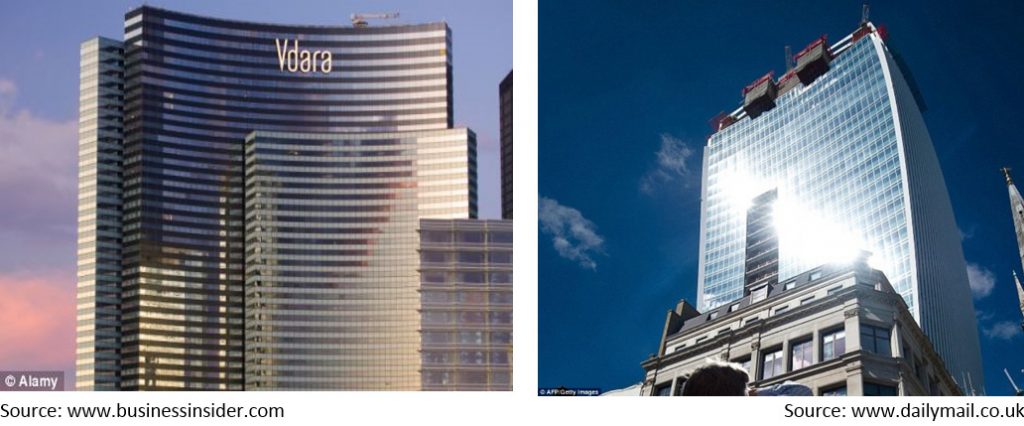How to Avoid Getting Burnt by Buildings
Posted on 26 February 2017
Neighbours of new developments and local government authorities are becoming increasingly aware of the potential impacts of solar reflectivity, whether in terms of visible light or thermal reflectance. To prevent such risks, Windtech Consultants carries out assessments of both visible light and thermal reflectance to predict and mitigate these effects before they happen.
Two of the most well-known projects in terms of solar thermal reflectance impact is the ‘Walkie Talkie’ high rise development in London, UK and the VDARA Hotel, Las Vegas. The concave form of the curtain wall façade of these developments concentrated solar reflections, increasing the intensity of both light and heat. The intensity was so severe in the instance of the ‘walkie talkie’ building that there was damage to nearby vehicles. This included warping of the exterior of these vehicles, as well as melting plastic components. In the case of the VDARA Hotel, there were reports that people received severe sunburns and that the outdoor pool temperature rose by 20 degrees. This effect is similar to pointing a magnifying glass to an object located close to the focal point of the lens.
To prevent such risks, Windtech Consultants carries out thermal reflectance modelling to predict these effects. An example is the detailed analysis into the solar thermal reflectance of the high rise structure proposed for 104-114 Scarborough St, Southport, Queensland. The analysis focused on the impact of solar thermal reflectance from the façade of the proposed development on the surrounding streets below.
Two seasonal cases were studied, namely autumn and summer, which are the most critical for solar thermal reflectance. The thermal conditions were assessed for a 12 hour period in total, ranging from 6:00am up until 6:00pm for the aforementioned seasons.
The analysis involved a hybrid approach, whereby a numerical model was generated using a computational fluid dynamics (CFD) package which was then combined with desktop calculations of occupant comfort parameters; namely the Standard Effective Temperature (SET), Predicted Mean Vote (PMV) as well as the Predicted Percentage Dissatisfied (PPD). These have been shown to more closely reflect a person’s perception of temperature. Additionally, occupant safety was also assessed by means of comparing the findings of the analysis against guidelines set out by the US organisation’s Federal Emergency Management Association (FEMA) as well as the US National Fire Protection Association (NFPA). Furthermore, an assessment was made of the background thermal conditions of the surrounding streetscapes (without the proposed building) to properly gauge the impact of the proposed development.
Return to Main News Page




